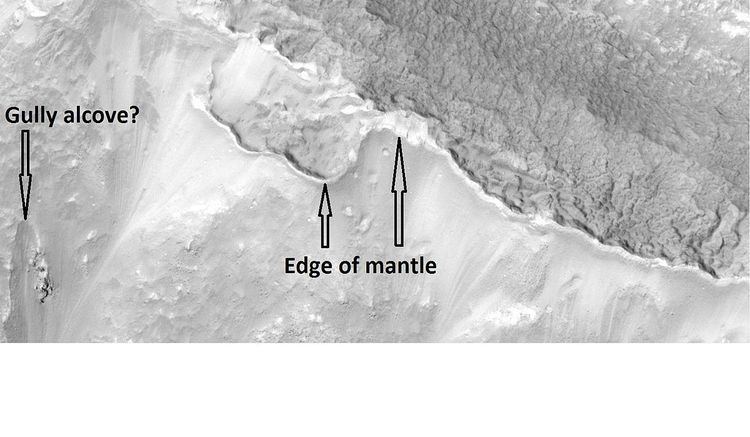 | ||
Polygonal, patterned ground is quite common in some regions of Mars. It is commonly believed to be caused by the sublimation of ice from the ground. Sublimation is the direct change of solid ice to a gas. This is similar to what happens to dry ice on the Earth. Places on Mars that display polygonal ground may indicate where future colonists can find water ice. Patterned ground forms in a mantle layer, called latitude dependent mantle, that fell from the sky when the climate was different.
Contents
Sizes and formation of polygonal ground
Polygonal ground is generally divided into two kinds: high center and low center. The middle of a high center polygon is 10 meters across and its troughs are 2–3 meters wide. Low center polygons are 5–10 meters across and the boundary ridges are 3–4 meters wide.
High center polygons are higher in the center and lower along their boundaries. It forms from increased sublimation around cracks in a surface. Cracks are common in ice-rich surfaces.
The cracks provide a place of increased surface area for sublimation. After a time the narrow cracks widen to become troughs.
Low center polygons are thought to develop from the high center polygons. The troughs along the edges of high center polygons may become filled with sediment. This thick sediment will retard sublimation, so more sublimation will take place in the center that is protected by a thinner lag deposit. In time, the middle becomes lower than the outer parts. The sediments from the troughs will turn into ridges.
Latitude dependent mantle
Much of the Martian surface is covered with a thick ice-rich, mantle layer that has fallen from the sky a number of times in the past. It fell as snow and ice-coated dust. This mantle layer is called "latitude dependent mantle" because its occurrence is related to the latitude. It is this mantle that cracks and then forms polygonal ground.
The mantle layer lasts for a very long time before all the ice is gone because a protective lag deposit forms on the top. The mantle contains ice and dust. After a certain amount of ice disappears from sublimation the dust stays on the top, forming the lag deposit.
Mantle forms when the Martian climate is different than the present climate. The tilt or obliquity of the axis of the planet changes a great deal. The Earth’s tilt changes little because our rather large moon stabilizes the Earth. Mars only has two very small moons that do not possess enough gravity to stabilize its tilt. When the tilt of Mars exceeds around 40 degrees (from today's 25 degrees), ice is deposited in certain bands where much mantle exists today.
Other surface features
Another type of surface is called "brain terrain" as it looks like the surface of a human brain. Brain terrain lies under polygonal ground when the two are both visible in a region.
Since the top, polygon layer is fairly smooth although the underlying brain terrain is irregular; it is believed that the mantle layer that contains the polygons is 10–20 meters thick.
"Basketball terrain" is another expression of the surface of Mars. At certain distances it looks like a basketball’s surface. Close-up pictures have revealed it to consist of piles of rocks. Many ideas have been advanced to explain how these piles of rocks are formed.
Many steep surfaces in latitude bands near 40 degrees North and South contain gullies. Some of the gullies show polygons. These have been called "gullygons."
Polygonal patterned ground on the Earth
On the Earth, polygonal, patterned ground is present in ice-rich ground, especially in polar regions.
